You can create effective natural pest barriers using diatomaceous earth, a fine powder made from fossilized diatoms that punctures soft-bodied insects’ exoskeletons and causes dehydration. Apply it in thin, continuous bands around plant bases and raised bed perimeters to control aphids, slugs, beetles, and earwigs without harsh chemicals. Always use food-grade DE and wear protective gear during application, while avoiding flowers to protect beneficial pollinators. Discover extensive techniques for maximizing your garden’s natural defense system.
What Is Diatomaceous Earth and How Does It Work
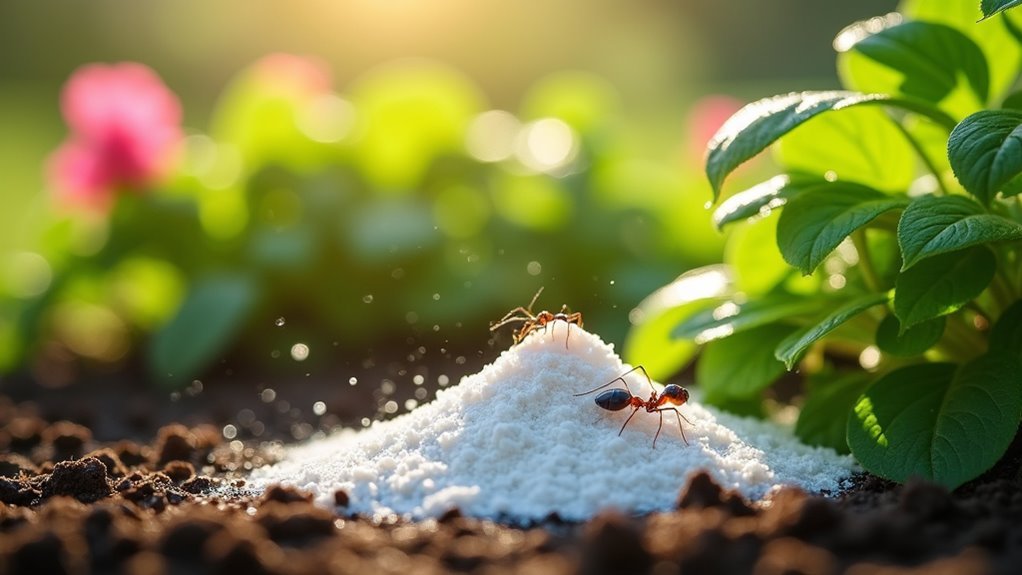
Gardeners seeking natural pest control solutions often turn to diatomaceous earth, a fine powder made from the fossilized remains of diatoms—microscopic aquatic organisms that lived millions of years ago.
This ancient powder harnesses millions of years of fossilized marine life to create an effective, natural solution for modern garden pest problems.
This silica-rich substance works through its abrasive properties and absorbent nature, making it effective for organic gardening pest control methods.
When you apply diatomaceous earth around plants, its microscopic sharp edges puncture soft-bodied insects’ exoskeletons. The powder’s natural origin as fossilized silica skeletons creates a desiccant that absorbs oils and fats from pest surfaces, disrupting their protective coatings and causing fatal dehydration.
However, you must use caution since it’s non-selective, potentially harming beneficial insects like pollinators alongside targeted pests.
Apply only during dry conditions for maximum effectiveness.
Types of Garden Pests Controlled by Diatomaceous Earth
While diatomaceous earth proves effective against numerous garden invaders, it’s particularly powerful against soft-bodied pests that wreak havoc on your plants.
You’ll find this organic pest control method works exceptionally well against aphids, eliminating the harmful leaf curling and sticky honeydew they produce. It creates an excellent barrier against slugs and snails that damage your lettuce and strawberries.
When you apply diatomaceous earth around your garden, it effectively deters various beetles, including flea, cucumber, and Japanese beetles through its abrasive properties.
You can also control earwigs that feed on seedlings and leaves. Mix it into soil to prevent root maggots from attacking plant bases.
Creating Effective Barrier Applications Around Plants

Once you’ve identified which pests diatomaceous earth can control, proper application becomes essential for creating protective barriers that actually work.
Apply DE in a thin, continuous band around plant bases during dry conditions to maximize its abrasive properties. Focus your dusting of DE around raised bed perimeters and individual plants, creating an inhospitable environment for crawling pests.
Avoid dusting flowers to protect beneficial insects like bees from harm. Using DE requires reapplication after rainfall or irrigation, as moisture diminishes its effectiveness.
For broader coverage, mix diatomaceous earth with water and spray affected plants, allowing it to dry into a protective barrier. This strategic pest management approach maintains plant health while deterring unwanted visitors.
Proper Application Methods for Maximum Effectiveness
You’ll achieve the best pest control results by applying diatomaceous earth as a thin, even layer during early morning or late evening hours when beneficial insects are less active.
Use a duster or shaker to create light coverage rather than thick piles that can impede plant growth while still maintaining effectiveness against target pests.
Don’t forget to reapply after rain or watering since moisture clumps the dust and greatly reduces its pest-controlling properties.
Timing and Coverage Techniques
When applying diatomaceous earth as a natural pest barrier, timing becomes essential for achieving peak effectiveness while protecting beneficial insects.
You’ll want to apply this natural alternative to chemical pesticides during early morning or late evening hours when pollinators are less active.
For optimal coverage techniques:
- Create uniform distribution – Use a dust applicator to spread a thin layer around the plant base and leaf undersides, ensuring even coverage without thick piles.
- Target soil preparation – Mix diatomaceous earth into the top 1-2 inches of soil before planting for root pest protection.
- Monitor weather conditions – Reapply diatomaceous earth after rain or irrigation to maintain barrier effectiveness.
- Consider wet application – Mix with water for broader coverage on both indoor and outdoor applications.
Reapplication After Weather Events
Rain and high humidity can quickly diminish diatomaceous earth’s pest-fighting power by causing it to clump together or wash away entirely from your treated areas.
You’ll need to reapply this natural pest barrier whenever moisture compromises its effectiveness. Check your plants regularly after weather events to assess whether reapplication is necessary.
Apply fresh diatomaceous earth during dry conditions when it’ll remain loose and active against pests.
Time your reapplication for early morning or late evening to protect beneficial insects like bees and butterflies from exposure.
Always maintain a thin layer rather than thick piles, which actually reduce the material’s desiccating action on insect exoskeletons.
Monitor pest activity levels to determine if your reapplication timing and coverage are effectively controlling unwanted garden visitors.
Safety Considerations for People, Pets, and Beneficial Insects
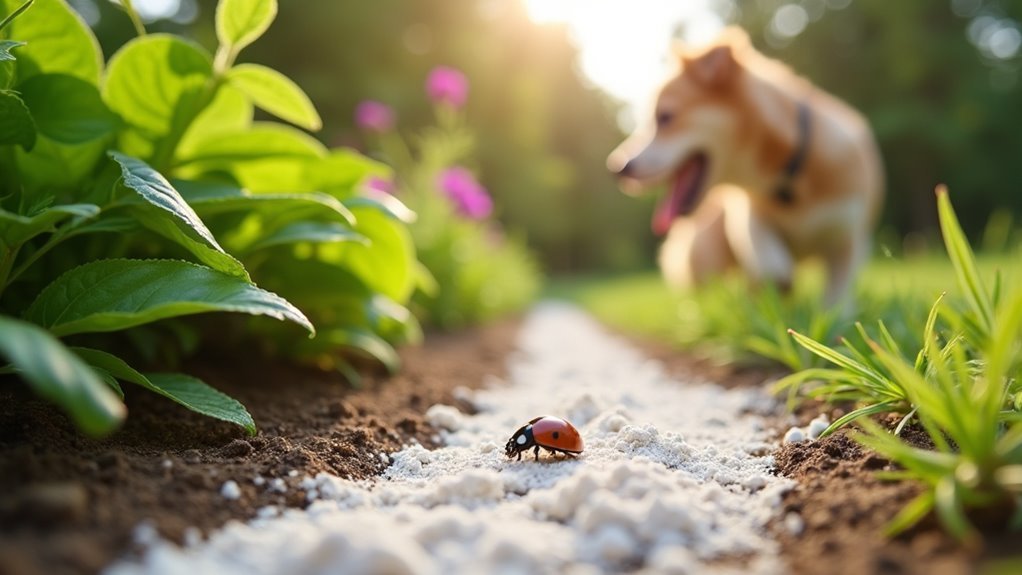
Although diatomaceous earth offers an effective natural pest control solution, you’ll need to take into account several safety factors to protect yourself, your pets, and the beneficial insects that help your garden thrive.
Food grade DE provides safe organic pest control compared to chemical pesticides, but proper application matters. While Diatomaceous Earth is safe for humans and pets, it can harm beneficial insects like bees and ladybugs.
Follow these essential safety guidelines:
- Wear protective gear including masks and goggles during application to prevent dust from entering your respiratory system.
- Avoid dusting flowers and pollinator-active areas to protect beneficial insects.
- Apply during calm weather to minimize drift onto unintended areas.
- Time reapplying D.E. after rain while considering wildlife activity patterns.
Food grade DE won’t irritate the respiratory system when applied correctly with proper precautions.
Maintenance and Reapplication Guidelines
Effective diatomaceous earth application requires consistent monitoring and timely reapplication to maintain its pest control benefits. You’ll need to reapply diatomaceous earth after rain or irrigation since moisture washes it away and reduces effectiveness. Regular garden inspections help you identify when reapplication is necessary, particularly after observing pest activity.
Apply diatomaceous earth during early morning or late evening hours to protect beneficial insects like bees and butterflies. Evenly distribute the powder, focusing on plant bases and leaf undersides where pests typically hide.
| Maintenance Task | Frequency |
|---|---|
| Inspect garden for pest activity | Weekly |
| Reapply after rain/irrigation | As needed |
| Check D.E. distribution | Every application |
| Monitor beneficial insect activity | Daily during treatment |
| Store D.E. properly | Continuously |
Proper storage in cool, dry conditions prevents clumping and maintains the product’s effective pest control properties.
Combining Diatomaceous Earth With Other Natural Pest Control Methods
While diatomaceous earth provides excellent standalone pest control, you’ll achieve superior results by integrating it with other natural pest management strategies.
Maximize your garden’s pest control effectiveness by combining diatomaceous earth with complementary natural management techniques for optimal results.
Combine diatomaceous earth with these proven methods:
- Companion planting – Plant marigolds or basil alongside your crops while applying diatomaceous earth as a protective barrier around plant bases for dual pest deterrence.
- Beneficial insects – Use diatomaceous earth strategically to target harmful pests while preserving ladybugs and lacewings that naturally control garden threats.
- Organic solutions – Mix diatomaceous earth applications with neem oil treatments to combat both soft-bodied insects and hard-shelled pests effectively.
- Crop rotation with mulching – Implement crop rotation schedules while using diatomaceous earth as top dressing over moisture-retentive mulches to disrupt pest life cycles and improve soil health simultaneously.
Frequently Asked Questions
Can Diatomaceous Earth Be Used to Create a Barrier Around Plants?
You can sprinkle diatomaceous earth around your plants to create an effective pest barrier. The sharp silica particles damage slug, snail, and beetle exoskeletons, causing dehydration and death when they cross it.
What Are the Downsides of Diatomaceous Earth?
You’ll face respiratory irritation if you inhale the dust, it’s ineffective when wet, and you’ll harm beneficial insects like bees. You can’t use pool-grade versions safely in gardens.
What Not to Mix With Diatomaceous Earth?
Don’t mix diatomaceous earth with wet substances, oils, chemical pesticides, high-moisture fertilizers, or moisture-retaining soil amendments. You’ll reduce its effectiveness and negate its natural pest control benefits if you combine it improperly.
Can I Sprinkle Diatomaceous Earth on My Vegetable Garden?
You can sprinkle food-grade diatomaceous earth on your vegetable garden to control soft-bodied pests like aphids and slugs. Apply thin layers around plant bases, avoid flowers, and reapply after watering.
In Summary
You’ve now learned how to harness diatomaceous earth’s natural pest-fighting power in your garden. By applying it correctly around your plants and reapplying after rain or watering, you’ll create effective barriers against crawling insects while protecting beneficial species. Remember to use food-grade DE, wear protective gear during application, and combine it with other natural methods for thorough pest management. With consistent use, you’ll maintain a healthier, chemical-free garden environment.

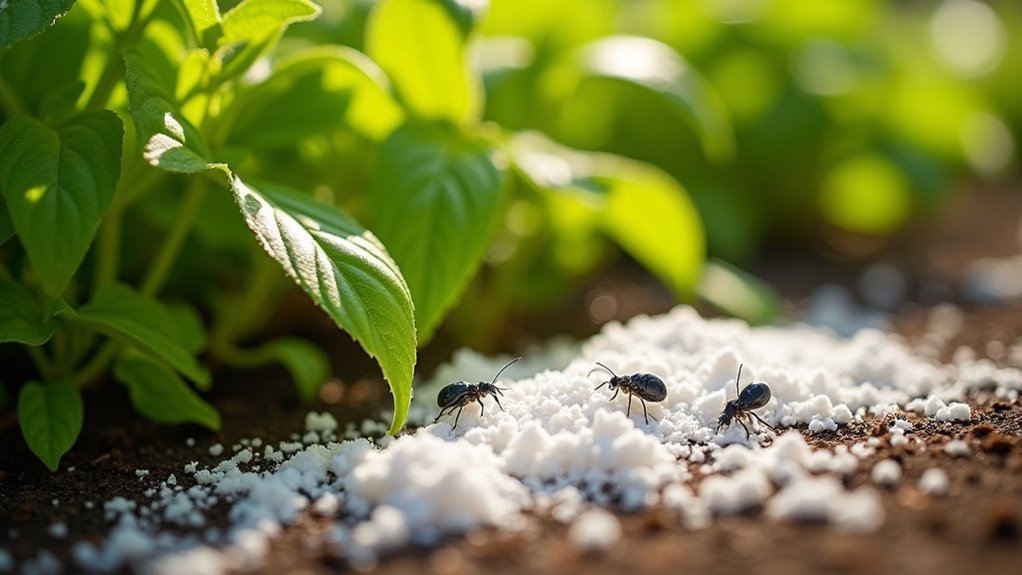
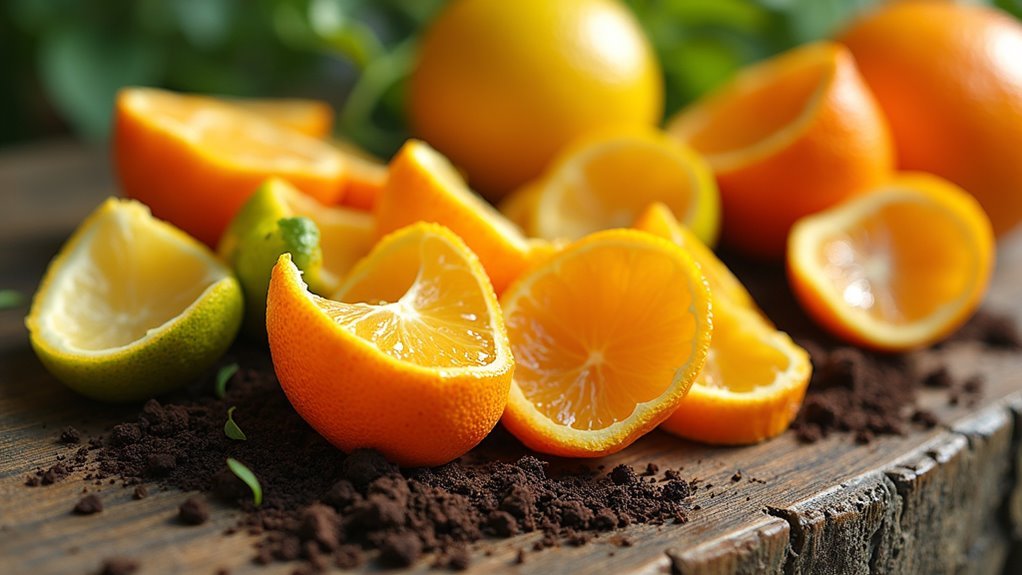

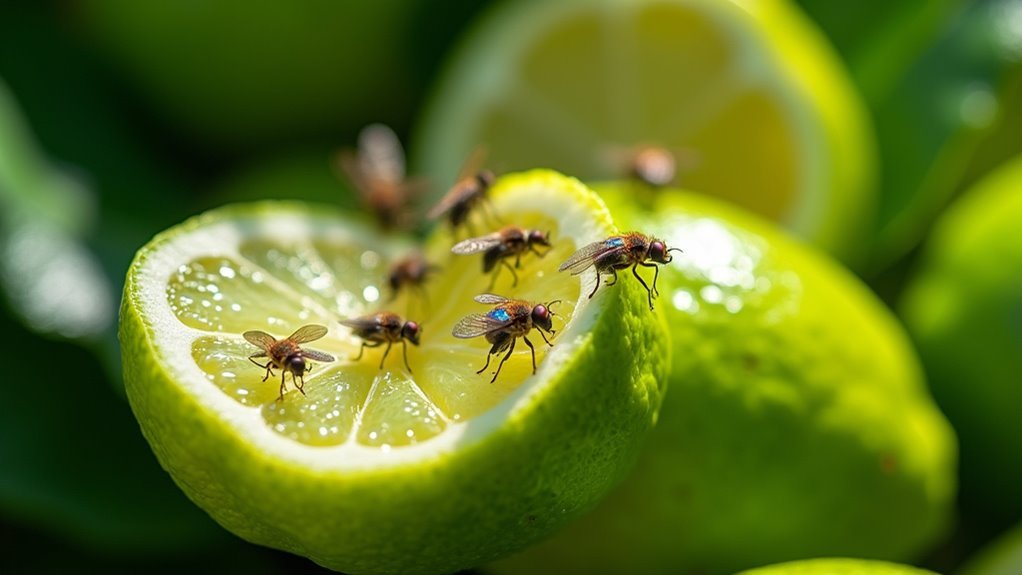
Leave a Reply